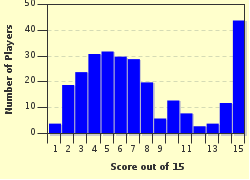Quiz Answer Key and Fun Facts
1. Fred Astaire began his career with his sister Adele in vaudeville and then Broadway. Which Broadway musical comedy featured George and Ira Gershwin's first complete score for Fred and Adele?
2. During the 1920s, Astaire continued to refine his dancing and would often study and watch other performers. Which African-American dancer did Astaire study with?
3. After his sister Adele retired in 1932, he performed in one more Broadway and London musical: "Gay Divorce". Who wrote the score?
4. Astaire and Rodgers performed in ten musicals together: nine at RKO between 1933-1939 and one produced by MGM in 1949. Which musical do we see Astaire actually kiss Rogers passionately at the culmination of a slow motion dance?
5. Astaire was one of the most versatile performers in Hollywood and played more than one musical instrument. Which instruments did he play?
6. Fred Astaire harbored a secret pipe dream to be a successful song-writer. In 1935, one of his 26 published songs reached #4 in the US pop charts. Which song was it?
7. Astaire was an innovator in the filming of dance on film. When he renegotiated his contract with RKO in 1934, he requested complete artistic control of his dances and musical numbers. However on most of his films, Astaire was not credited as the Choreographer or Dance Director. Which choreographer did Astaire often collaborate with?
8. In 1951, Astaire received an award for his performance as song writer/magician Burt Kalmar in "Three Little Words". What was the award?
9. Although Astaire never cared for his singing voice, he introduced some of the most celebrated songs from the "Great American Songbook" and recorded several records. In the early 1950s, Astaire recorded an album called "The Astaire Story" featuring which great jazz band or pick-up group?
10. Fred Astaire is well known for his unique ability to make the inanimate into animates by his use of various props. He danced with a coat rack, drums, typewriter, fireworks, grand piano, etc in addition to scores of beautiful ladies and handsome men. Which of the following items did Astaire NOT dance with?
11. In 1959, Astaire published his autobiography. It was written long hand (no type writer) and without a ghostwriter. What is the name of the book?
12. When Astaire decided to star and produce his first television special, "An Evening with Fred Astaire," it won an unprecedented nine Emmy Awards. Who was the corporate sponsor?
13. In 1957, Astaire starred in his 30th musical film, "Silk Stockings," with Cyd Charisse. He began to seriously consider acting in dramatic movies. Although he appeared in one more musical, Astaire had roles in several non-musical films. What was his first dramatic film role on the big screen?
14. Astaire earned his first and only Academy Award nomination, for his role in "The Towering Inferno". However, Astaire won several Emmy Awards over the course of his career. Which TV movie did Astaire win an Emmy for Outstanding Lead Actor in a Movie/Miniseries?
15. Astaire was an extremely talented and versatile entertainer. However, it is his musical films that he will always be best remembered for. His influence reached generations of dancers. Which choreographer created a ballet that was directly based on one of Astaire's routines, "I'm Old Fashioned" and is shown during live performances of the ballet?
Source: Author
Yowsers74
This quiz was reviewed by FunTrivia editor
gtho4 before going online.
Any errors found in FunTrivia content are routinely corrected through our feedback system.

